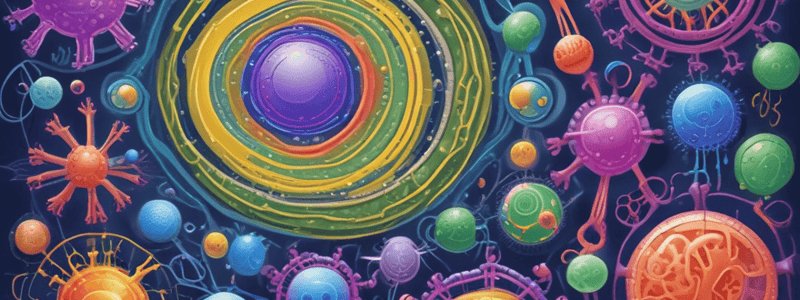Podcast
Questions and Answers
What is the study of plants and their interactions with the environment?
What is the study of plants and their interactions with the environment?
- Microbiology
- Zoology
- Ecology
- Botany (correct)
What is the control center of the cell where DNA is stored?
What is the control center of the cell where DNA is stored?
- Nucleus (correct)
- Cytoplasm
- Mitochondria
- Chloroplasts
What is the process by which sex cells are formed?
What is the process by which sex cells are formed?
- Meiosis (correct)
- Photosynthesis
- Mitosis
- Respiration
What is the term for the variety of different species within an ecosystem?
What is the term for the variety of different species within an ecosystem?
What are structures that are similar in different species but have different functions?
What are structures that are similar in different species but have different functions?
What is the process by which organisms that are better adapted to their environment are more likely to survive and reproduce?
What is the process by which organisms that are better adapted to their environment are more likely to survive and reproduce?
What is the molecule that contains genetic information?
What is the molecule that contains genetic information?
What is the sequence of organisms that eat other organisms?
What is the sequence of organisms that eat other organisms?
Flashcards are hidden until you start studying
Study Notes
Branches of Biology
- Botany: study of plants and their interactions with the environment
- Zoology: study of animals and their interactions with the environment
- Microbiology: study of microorganisms such as bacteria, viruses, and fungi
- Ecology: study of the relationships between organisms and their environment
Cells
- Cell membrane: semi-permeable membrane that separates the cell from its environment
- Cytoplasm: jelly-like substance inside the cell membrane where metabolic processes occur
- Nucleus: control center of the cell where DNA is stored
- Mitochondria: organelles responsible for generating energy for the cell
- Chloroplasts: organelles found in plant cells responsible for photosynthesis
Genetics
- DNA (Deoxyribonucleic acid): molecule that contains genetic information
- Genes: segments of DNA that code for specific traits
- Chromosomes: thread-like structures made up of DNA and proteins that carry genes
- Meiosis: process by which sex cells (gametes) are formed
- Mendel's laws: principles of inheritance that describe how genes are passed down from generation to generation
Evolution
- Natural selection: process by which organisms that are better adapted to their environment are more likely to survive and reproduce
- Speciation: process by which a new species emerges from an existing one
- Fossil record: evidence of the history of life on Earth preserved in rocks and fossils
- Homologous structures: structures that are similar in different species but have different functions
Ecosystems
- Ecosystem: community of living and non-living things that interact with each other
- Biodiversity: variety of different species within an ecosystem
- Food chain: sequence of organisms that eat other organisms
- Energy pyramid: representation of the energy available at each level of a food chain
Branches of Biology
- Botany is the study of plants and their interactions with the environment, providing insights into plant structure, growth, and evolution.
- Zoology is the study of animals and their interactions with the environment, exploring animal behavior, physiology, and diversity.
- Microbiology examines microorganisms such as bacteria, viruses, and fungi, which are crucial for understanding disease and the environment.
- Ecology studies the relationships between organisms and their environment, focusing on the delicate balance of ecosystems.
Cells
- The cell membrane is a semi-permeable membrane that separates the cell from its environment, regulating what enters and leaves the cell.
- Cytoplasm is the jelly-like substance inside the cell membrane where metabolic processes occur, such as protein synthesis and cell signaling.
- The nucleus is the control center of the cell where DNA is stored, containing the genetic instructions for cell growth and function.
- Mitochondria are organelles responsible for generating energy for the cell through cellular respiration.
- Chloroplasts are organelles found in plant cells responsible for photosynthesis, producing energy from sunlight.
Genetics
- DNA (Deoxyribonucleic acid) is a molecule that contains genetic information, providing the blueprint for an organism's development and function.
- Genes are segments of DNA that code for specific traits, influencing an organism's characteristics and susceptibility to disease.
- Chromosomes are thread-like structures made up of DNA and proteins that carry genes, determining an organism's genetic makeup.
- Meiosis is the process by which sex cells (gametes) are formed, allowing for genetic diversity and inheritance.
- Mendel's laws are principles of inheritance that describe how genes are passed down from generation to generation, predicting the likelihood of certain traits.
Evolution
- Natural selection is the process by which organisms that are better adapted to their environment are more likely to survive and reproduce, driving evolutionary change.
- Speciation is the process by which a new species emerges from an existing one, resulting from geographic isolation and genetic divergence.
- The fossil record is evidence of the history of life on Earth, preserved in rocks and fossils that provide insights into evolutionary history.
- Homologous structures are structures that are similar in different species but have different functions, indicating a common evolutionary origin.
Ecosystems
- An ecosystem is a community of living and non-living things that interact with each other, including plants, animals, microorganisms, and the physical environment.
- Biodiversity refers to the variety of different species within an ecosystem, influencing ecosystem resilience and function.
- A food chain is a sequence of organisms that eat other organisms, illustrating the flow of energy and nutrients through an ecosystem.
- An energy pyramid is a representation of the energy available at each level of a food chain, demonstrating the inefficiency of energy transfer and the importance of primary producers.
Studying That Suits You
Use AI to generate personalized quizzes and flashcards to suit your learning preferences.




